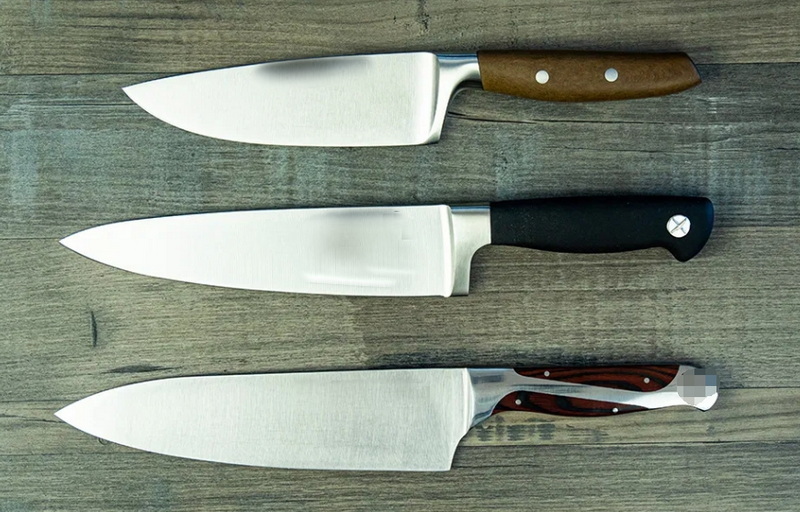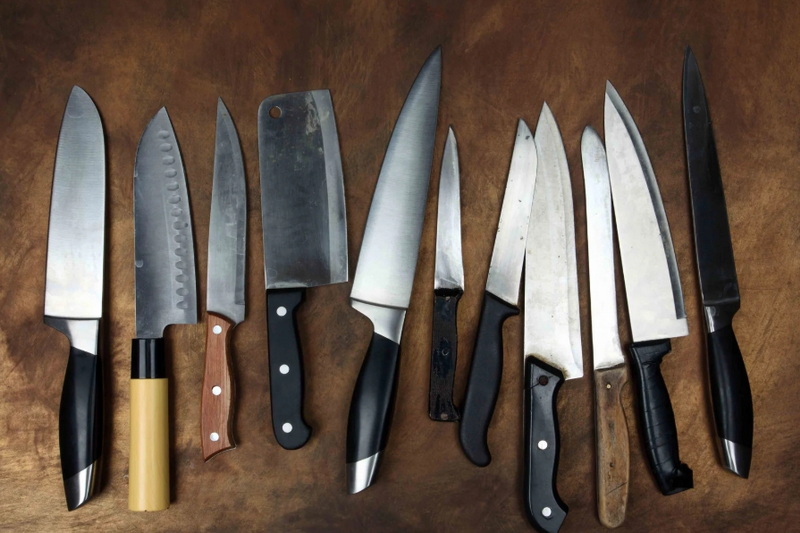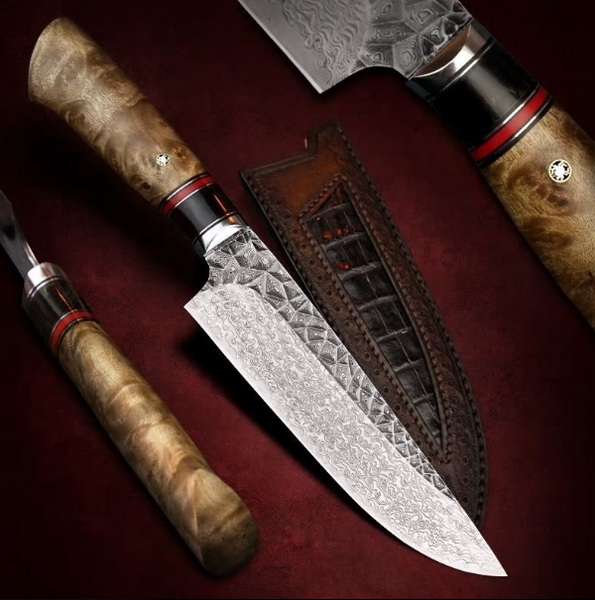

Views: 222 Author: Ella Publish Time: 2025-05-05 Origin: Site








Content Menu
● Blade Material: The Foundation of Performance
● Sharpness and Edge Retention: Precision and Longevity
● Handle Comfort and Grip: Ergonomics for Safety and Control
● Weight and Balance: Finding Your Ideal Feel
● Blade Shape and Size: Versatility and Specific Tasks
● Forged vs. Stamped Blades: Craftsmanship and Durability
● Additional Features to Consider
● Frequently Asked Questions (FAQ)
>> 1. What is the best blade material for a chef knife?
>> 2. How do I know if a knife handle is comfortable?
>> 3. What size chef knife should I buy?
>> 4. How often should I sharpen my chef knife?
>> 5. What is the difference between forged and stamped knives?
Choosing the right chef knife is essential for any cook, whether a professional chef or a home enthusiast. A high-quality chef knife not only makes food preparation easier and more enjoyable but also enhances precision and safety in the kitchen. This comprehensive guide explores the key features to look for when selecting a chef knife, helping you make an informed decision that suits your cooking style and needs.

The blade material is the most critical factor affecting a chef knife's sharpness, durability, maintenance, and overall performance.
- Stainless Steel: Stainless steel blades offer excellent rust resistance and durability, making them ideal for busy kitchens where low maintenance is preferred. Modern high-carbon stainless steel blends sharpness with corrosion resistance, providing a practical balance for everyday use. These blades are less prone to staining and easier to clean, which is especially important in humid or wet environments.
- Carbon Steel: Carbon steel is known for superior sharpness and edge retention. These blades can be sharpened to an extremely fine edge and maintain it longer than many stainless steel blades. However, carbon steel requires more care to prevent rust and staining, as it is more reactive to moisture and acidic foods. Over time, carbon steel blades develop a unique patina, which many chefs appreciate as a sign of character and use.
- Damascus Steel: Damascus steel knives combine aesthetics with functionality. These blades feature layered steel patterns created by folding and forging different types of steel together. This layering not only results in beautiful, distinctive patterns but also offers a balance of sharpness, edge retention, and toughness. Damascus knives often come with a high-carbon core for sharpness, wrapped in softer stainless layers for durability and corrosion resistance.
Choosing the right blade material depends on your willingness to maintain the knife and your preference for sharpness versus ease of care. For example, if you prefer a low-maintenance knife that resists rust, stainless steel is a great choice. If you want a razor-sharp edge and don't mind extra care, carbon steel is excellent.
A sharp blade reduces effort and improves cutting accuracy, making food preparation safer and more enjoyable. Look for knives that maintain their edge for long periods to minimize frequent sharpening.
- Edge Angle: The angle at which the blade is sharpened affects sharpness and durability. Japanese knives typically have a sharper edge angle, around fifteen to sixteen degrees, offering finer precision but requiring more careful handling. Western knives usually have a wider angle, around twenty degrees, which provides greater durability and ease of sharpening. A sharper edge angle means a thinner edge, which cuts more easily but may dull faster or chip if misused.
- Hardness: Blade hardness is measured on the Rockwell Hardness Scale, which rates the steel's resistance to deformation. Harder blades, with scores above sixty, hold an edge longer but can be more brittle and prone to chipping if used improperly. Softer blades, scoring between fifty-five and sixty, are more forgiving and easier to sharpen at home but may require more frequent maintenance.
- Edge Retention: This refers to how long a knife stays sharp during regular use. High-quality steel and proper heat treatment improve edge retention. Some knives come with coatings or treatments that enhance durability and reduce friction when cutting.
Regular honing and occasional sharpening with quality tools are essential to keep your knife performing well. Honing realigns the blade's edge, while sharpening removes metal to create a new edge. Using a honing rod regularly can extend the time between sharpenings.
The handle is your point of contact with the knife, so comfort and grip are paramount for both safety and control.
- Materials: Common handle materials include wood, resin-infused composites, and synthetic polymers. Wooden handles offer a warm, natural feel and can be very durable when properly treated, but they require more maintenance to prevent cracking or absorbing moisture. Resin-infused or composite handles provide excellent durability and are often dishwasher safe, making them low maintenance. Synthetic polymers, such as polypropylene or micarta, offer a good balance of grip, durability, and ease of cleaning.
- Ergonomics: A well-designed handle reduces hand fatigue during prolonged use. Look for handles shaped to fit comfortably in your hand with a secure grip, even when wet. Handles with textured surfaces or finger grooves can improve grip and control, especially when working with slippery ingredients.
- Balance: The handle should balance the blade's weight to provide control and reduce wrist strain. Full-tang knives, where the blade metal extends through the handle, often offer better balance and durability. The weight distribution between blade and handle affects how the knife feels during cutting motions. A balanced knife feels natural and effortless, allowing for precise cuts.

Knife weight and balance significantly affect usability and comfort in the kitchen.
- Weight: Some cooks prefer heavier knives for their cutting power, especially when working with tougher ingredients like squash or bone-in meats. Heavier knives can provide momentum, reducing the effort needed to slice through dense foods. Others favor lighter knives for precision and speed, particularly when performing delicate tasks such as mincing herbs or slicing thin cuts of fish.
- Balance Point: Ideally, the knife's balance point should be near the bolster, the thick junction between blade and handle. This balance allows smooth rocking motions and better control. A knife that is too blade-heavy or handle-heavy can cause fatigue and reduce cutting accuracy.
Testing different knives in hand before purchasing can help identify your preferred weight and balance. Many kitchen stores allow customers to hold and try knives to get a feel for their ergonomics.
The blade's shape and length influence how versatile and comfortable the knife is for various kitchen tasks.
- Blade Length: Most chef knives range from six to twelve inches. An eight-inch blade is the most popular and versatile size for general use, offering a good balance between control and cutting surface. Smaller blades (six to seven inches) are easier to maneuver and better suited for detailed work or smaller hands. Larger blades (nine to twelve inches) can handle bigger tasks but may be unwieldy for some users.
- Blade Curve: A curved blade allows rocking motions for chopping herbs and vegetables, making cutting faster and more efficient. A straighter blade is better for slicing and push cuts, providing cleaner cuts on meats and fish.
- Tip Shape: A sharp pointed tip is useful for intricate cuts, piercing, and working in tight spaces. A rounded tip provides safer, more controlled chopping and reduces the risk of accidental punctures.
- Blade Thickness: Thinner blades offer precision and ease slicing, especially for delicate ingredients like fish or soft vegetables. Thicker blades provide durability for tougher tasks like cutting through root vegetables or harder meats.
Choosing the right blade shape and size depends on your cooking style and the types of food you prepare most often.
Understanding the difference between forged and stamped knives can help you choose a knife that matches your needs and budget.
- Forged Knives: Forged knives are made from a single piece of steel heated and hammered into shape. This process creates a denser, stronger blade that often includes a bolster for finger protection and balance. Forged knives tend to be heavier and more balanced, providing better control and durability. They are usually more expensive due to the labor-intensive manufacturing process.
- Stamped Knives: Stamped knives are cut from a steel sheet and then shaped and sharpened. They are lighter and often less expensive but may lack the durability and balance of forged knives. Stamped knives usually do not have a bolster and may have a thinner blade profile.
Both types can perform well, but forged knives are generally preferred by professional chefs for their robustness and feel.
Beyond the core elements, several additional features can enhance your chef knife experience:
- Full Tang Construction: A full tang means the blade metal extends through the entire handle, increasing the knife's strength and balance. This construction reduces the risk of the handle breaking or loosening over time.
- Bolster: The bolster is the thick junction between blade and handle that adds balance and finger protection. It also provides a smooth transition for your hand when gripping the knife.
- Maintenance Requirements: Consider how much time you want to spend sharpening and caring for your knife. Some knives require frequent honing and careful storage, while others are more forgiving.
- Aesthetics: While not essential, many chefs appreciate the craftsmanship and design of knives, especially those with Damascus patterns or custom handles. A beautiful knife can inspire creativity and pride in your cooking.
Proper care extends the life and performance of your chef knife and ensures it remains safe and efficient to use.
- Hand Wash and Dry Immediately: Always wash your knife by hand with mild soap and water, then dry it immediately to prevent rust and corrosion. Avoid putting knives in the dishwasher, as harsh detergents and high heat can damage the blade and handle.
- Use Appropriate Cutting Boards: Use wood or plastic cutting boards to protect the blade's edge. Hard surfaces like glass, stone, or metal can dull or chip the blade quickly.
- Hone Regularly: Use a honing rod to realign the blade's edge before or after each use. This keeps the edge sharp and reduces the need for frequent sharpening.
- Sharpen Occasionally: Depending on usage, sharpen your knife two to three times a year. Use a whetstone, professional sharpening service, or a quality sharpening tool.
- Store Safely: Store knives in a block, sheath, or magnetic strip to protect the edges and prevent accidents.
Selecting the perfect chef knife involves balancing blade material, sharpness, handle comfort, weight, balance, and blade shape to suit your cooking style and needs. Investing in a quality knife with proper care will reward you with years of precise, efficient, and enjoyable food preparation. Whether you prefer the low-maintenance durability of stainless steel or the razor-sharp edge of carbon steel, understanding these key features empowers you to choose a chef knife that becomes your trusted kitchen companion.
Remember, the best knife is one that feels comfortable in your hand, suits your cooking tasks, and fits your maintenance preferences. Take the time to test different knives and learn proper care techniques to maximize your investment.

High-carbon stainless steel is often considered the best for combining sharpness, edge retention, and rust resistance. Carbon steel offers superior sharpness but requires more maintenance, while Damascus steel provides a balance of performance and aesthetics.
A comfortable handle fits your hand size and grip style, providing a secure, non-slip hold even when wet. Trying different knives in person is the best way to assess comfort and balance.
An eight-inch blade is the most versatile and popular size for general kitchen tasks. Smaller hands may prefer six to seven inches, while larger hands or heavy-duty tasks might benefit from nine to ten inches.
Sharpening frequency depends on use, but generally two to three times a year is sufficient for home cooks. Regular honing helps maintain the edge between sharpenings.
Forged knives are crafted from a single piece of steel, offering better balance, durability, and often a bolster for finger protection. Stamped knives are cut from steel sheets and are lighter and usually less expensive but may lack the robustness of forged knives.